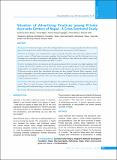Please use this identifier to cite or link to this item:
https://hdl.handle.net/20.500.14356/894Full metadata record
| DC Field | Value | Language |
|---|---|---|
| dc.contributor.author | Bohara, Surendra Kumar | - |
| dc.contributor.author | Regmi, Prerok | - |
| dc.contributor.author | Chapagain, Krishna Prasad | - |
| dc.contributor.author | Bhatta, Preeti | - |
| dc.contributor.author | Karki, Kanchan | - |
| dc.date.accessioned | 2023-04-03T09:27:29Z | - |
| dc.date.available | 2023-04-03T09:27:29Z | - |
| dc.date.issued | 2022 | - |
| dc.identifier.citation | Bohara S. K., RegmiP., Chapagain K. P., Bhatta P., & Karki K. (2022). Situation of Advertising Practices among Private Ayurveda Centers of Nepal - A Cross Sectional Study. Journal of Nepal Health Research Council, 20(02), 377-382. https://doi.org/10.33314/jnhrc.v20i02.3977 | en_US |
| dc.identifier.issn | Print ISSN: 1727-5482; Online ISSN: 1999-6217 | - |
| dc.identifier.uri | http://103.69.126.140:8080/handle/20.500.14356/894 | - |
| dc.description | Original Article | en_US |
| dc.description.abstract | Abstract Background: Advertisement plays a vital role in seeking health care services among the people. After the free market policy, advertising has been used by different private institutions for the promotion of their businesses. Methods: A descriptive cross-sectional study was done among the 40 private Ayurveda centers registered in the province registry of Nepal using convenience sampling. Semi-structured Interview and Key Informant interviews techniques were undertaken for quantitative and qualitative data collection. Data collected was edited, cleaned, and entered in MS-Excel, followed by analysis in the SPSS 22 version. Results: Correlation between investment in advertisement and patient flow was found to be highly significant with a relation of 0.89 at 99% confidence level (p-value 0.01). Linear regression analysis shows 77.8 percent variability in the patient flow was explained by advertising. A one-unit increase advertisement investment was found to bring about 0.744 unit increase in patient flow. Unregulated advertising was done through Television, Radio, magazines, social media, and pamphlets. Free health camps conducted by the centers, and patient-to-patient referrals were found to be emerging ways. The phrases in ads like “100% cure” were replaced by the phrases such as “successful treatment” and “without operation treatment”. Conclusions: This study shows unregulated, haphazard, and unethical advertising predominant among the private centres. There is a need for proper enforcement of the regulating act, formulation of proper guidelines about advertising, social media advertising, its content and censorship before broadcasting. Keywords: Advertisement; ayurveda; private centers; satisfaction | en_US |
| dc.language.iso | en | en_US |
| dc.publisher | Nepal Health Research Council | en_US |
| dc.relation.ispartofseries | April-June, 2022;3977 | - |
| dc.subject | Advertisement | en_US |
| dc.subject | Ayurveda | en_US |
| dc.subject | Private centers | en_US |
| dc.subject | Satisfaction | en_US |
| dc.title | Situation of Advertising Practices among Private Ayurveda Centers of Nepal - A Cross Sectional Study | en_US |
| dc.title.alternative | A Cross Sectional Study | en_US |
| dc.type | Journal Article | en_US |
| Appears in Collections: | Vol 20 No 02 Issue 55 April-June, 2022 | |
Files in This Item:
| File | Description | Size | Format | |
|---|---|---|---|---|
| 3977-Manuscript-29683-1-10-20221103.pdf | Full Text. | 315.6 kB | Adobe PDF |  View/Open |
Items in DSpace are protected by copyright, with all rights reserved, unless otherwise indicated.
